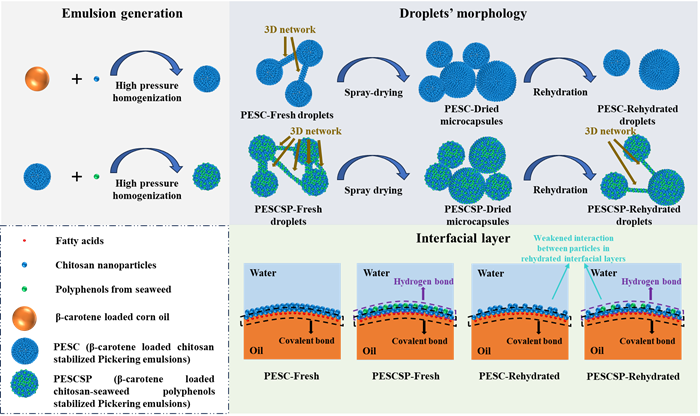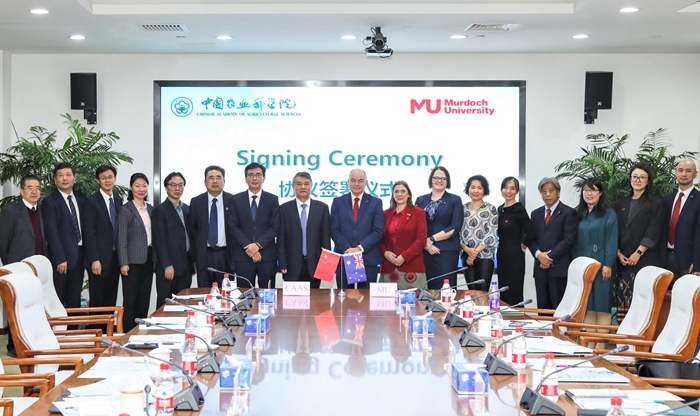Spray-drying and rehydration on β-carotene encapsulated Pickering emulsion with chitosan and seaweed polyphenol
Recently, the Root and Tuber Crops Food Science and Technology Innovation Team of Institute of Food Science and Technology, Chinese Academy of Agricultural Sciences (IFST-CAAS) investigated the spray-drying and rehydration on β-carotene encapsulated Pickering emulsion with chitosan and seaweed polyphenol. This work was published in the top journal "International Journal of Biological Macromolecules" (JCR Q1, IF=8.2).
Oil-in-water (O/W) Pickering emulsions can be used to encapsulate and deliver hydrophobic bioactive compounds (such as β-carotene). Spray-drying of fresh emulsion to form microcapsules powder can inhibit the growth of emulsion microorganisms, fatty acid rancidity and extend its shelf life. However, the high temperatures during spray drying and the contact of air with the emulsion droplets can cause oxidative degradation of β-carotene. Seaweed polyphenols has powerful antioxidant activity, the application of these compounds as a Pickering emulsion stabilizer could prevent degradation of encapsulated β-carotene during spray drying, although this potential application has not been explored to date.
Furthermore, β-carotene-loaded emulsion microcapsules can be introduced into various food matrices after rehydration. Therefore, rehydrated emulsion from microcapsules should have similar physiochemical properties to fresh emulsion. However, there is currently a lack of research that analyzes the interfacial layer properties of fresh and rehydrated Pickering emulsions to reveal the stabilization mechanism during spray drying and rehydrated processes.
This study proved that the encapsulated β-carotene in chitosan-seaweed polyphenol stabilized Pickering emulsion microcapsules had a higher retention yield than chitosan stabilized emulsion microcapsules. The rehydrated chitosan-seaweed polyphenol stabilized Pickering emulsion had smaller droplet size and lower redispersibility index (1.5) as well as stronger 3D network structure and higher stability. In addition, the chitosan in the interfacial layer was covalently bound to the fatty acids of the oil phase on its hydrophobic side, as well as bound to seaweed polyphenols on its hydrophilic side through hydrogen bonds. This complex interfacial layer structure had stronger stability and antioxidant activity, inhibiting the oxidative degradation of encapsulated β-carotene. Overall, this study explored chitosan-seaweed polyphenol Pickering emulsion microcapsules which can be spray-dried and rehydrated contributing to the development of efficient delivery systems for β-carotene and other heat-sensitive bioactive compounds during spray drying and rehydration.
Prof. Taihua Mu, Prof. Hongnan Sun and Dr. Marco Garcia-Vaquero are the corresponding authors and the UCD-CAAS program PhD student Weihao Meng is the first author. This study was funded by the Science and Technology Innovation Project of Chinese Academy of Agricultural Sciences (CAAS-ASTIP-202X-IFST).
Link:https://doi.org/10.1016/j.ijbiomac.2024.131654

-
 May 11, 2024WRI Deepens Agricultural Technology Cooperation with Agricultural Research Institutions in Uzbekistan
May 11, 2024WRI Deepens Agricultural Technology Cooperation with Agricultural Research Institutions in Uzbekistan -
 Apr 28, 2024CAAS President Meets President of Murdoch University
Apr 28, 2024CAAS President Meets President of Murdoch University -
 Apr 18, 2024Opening Ceremony of the Training Workshop on Wheat Head Scab Resistance Breeding and Pest Control in Africa Held in CAAS
Apr 18, 2024Opening Ceremony of the Training Workshop on Wheat Head Scab Resistance Breeding and Pest Control in Africa Held in CAAS -
 Apr 03, 2024IPPCAAS Co-organized the Training Workshop on Management and Application of Biopesticides in Nepal
Apr 03, 2024IPPCAAS Co-organized the Training Workshop on Management and Application of Biopesticides in Nepal -
 Mar 28, 2024Delegation from the School of Agriculture and Food Science of University College Dublin, Ireland Visit to IAS, CAAS
Mar 28, 2024Delegation from the School of Agriculture and Food Science of University College Dublin, Ireland Visit to IAS, CAAS
